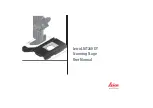
Pressure Systems, Inc. Model 9116 User’s Manual
Page 20
www.PressureSystems.com
A typical UDP/IP command (contained in the data field following a UDP packet header) is also a
variable length character string, but has a simpler format. Generally, it has a variable length
command string
(
cccccc
), followed by one optional
datum
(
dddd
) field (preceded by one
space
character):
“
cccccc
[
dddd
]”
Since there are only a few simple UDP/IP commands, all references to
commands
below should
assume TCP/IP commands, unless otherwise indicated.
3.1.2.2
Command Field
All
Model 9116
scanners recognize a set of predefined commands. Most are TCP/IP
commands, having only a single alphabetic letter for a
command
field. These are recognized
only when a formal
socket
connection is established with the host computer. A few are UDP/IP
commands with a longer
command
field. These are recognized any time the module has power
applied. All commands are functionally summarized in the following sections and detailed in
reference
Section 3.2
.
3.1.2.3
Position Field
The
Model 9116
Intelligent Pressure Scanner may contain up to sixteen (16) separate
input/output channels. When commands affect
certain channels
scanned by the module, the
position
field is used to identify those channels as bits in a bit map. If a channel’s corresponding
bit in the
position
field is set to a one (1), then that channel is affected by the command. The
least-significant (rightmost) bit 0 corresponds to Channel 1, and the most-significant (leftmost)
bit 15 corresponds to Channel 16. Since neither model has more than sixteen (16) channels,
the
position field
will usually be 16-bits, represented by four (4) ASCII-hex characters in the
command. For example, only Channels 16 and 1 are selected below in this 16-bit (4-character)
position field:
Bit# 15 14 13
12 11 10 9 8 7 6 5 4 3 2 1 0
Chan#
16
15 14
13 12 11
10 9 8 7 6 5 4 3 2
1
Binary 1 0 0 0 0 0 0 0 0 0 0 0 0 0 0 1
Hex
8 0 0 1
The above
position field
, with
all
applicable bits set (i.e., FFFF for 16-channel module), specifies
all channels
. However, a module-independent variation allows a
missing position field
to
designate
all channels
— but only when there are no other parameters following the
position
field
in the command. For such commands, the hex
position field
may be reduced to 3, 2, or 1
characters when no channel bits need be set (1) in the discarded high-order characters
(nibbles).
Note
The channel data requested will always be returned in order of
highest requested channel to lowest requested channel.















































